April 6, 1936 Gainesville Tornado Aftermath
One of the deadliest tornadoes in American history hit Gainesville, Georgia on April 6, 1936. And Lewis Reed was there to capture the aftermath. On the 88th anniversary of this epic tornado, I have posted eleven original snippets of history that Lewis Reed captured through the lens of his camera that day.
It all started as part of a storm system that hit Tupelo, Mississippi on April 5th, 1936. The Tupelo tornado, which registered as an F5 on the Fujita Scale, emerged from a complex system of storm cells and created a monster soon known as the fourth-deadliest tornado in U.S. history. It tore through houses, killed entire families and was even said to have left pine needles embedded into trunks of trees. One of the survivors of that storm in Tupelo was none other than a one-year-old Elvis Presley.
Unfortunately, the tragedy of that storm didn’t stop there. The system moved east overnight.
Take a look at some of the sobering aftermath photos of the deadliest tornado to ever hit Georgia … through the lens of Lewis Reed. As always, click the photos to get a better look.

View of part of the damage done to the Pacolet Manufacturing Company when a tornado struck the area. This textile mill had been established in 1901. New Holland was a community located just north of Gainesville. Photo by Lewis Reed
The devastating tornado continued beyond Gainesville, next striking New Holland, about two miles to the east, where it heavily damaged the massive Pacolet Mill, a major producer of textiles (as well as nearly 100 homes). The Digital Library of Georgia states that the Pacolet Mill was heavily damaged. Remarkably, no one in the mill was injured, as the workers saw the storm coming and evacuated from the upper floors, then ran to the building’s northeast end which remained intact after the tornado struck. (They knew where to take refuge as a result of an earlier tornado which struck in 1903, killing about 50 people in the mill.) After extensive repairs, Pacolet Mill resumed operation.
The overall destruction was barely able to be tallied. Department stores collapsed killing dozens of people, residential areas were devastated with nearly 750 homes destroyed and more than 250 were badly damaged. Buildings caught fire, trapping people inside. It was even reported that the winds were so high that letters from Gainesville were blown almost 70 miles away and found in Anderson, South Carolina.
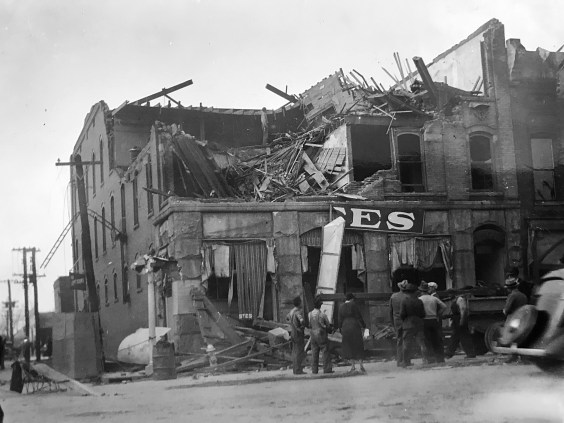
A man stands on second floor piles of rubble amidst the ruins of a demolished business. Only a few partial walls and floors were able to withstand the tornado strike. Photo by Lewis Reed
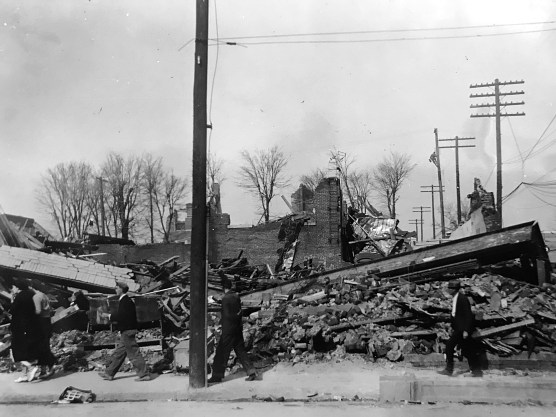
Stunned survivors survey what’s left of their town in this view of the widespread damage in the city streets. Photo by Lewis Reed

The storm that struck with ‘lightning swiftness’ hit the Royal Theatre straight on, also doing major damage to train cars and train tracks running through town. Utility poles were blown over and hung with twisted metal. Photo by Lewis Reed.

This photo documents the power of the tornado to toss around even massive railroad cars. Photo by Lewis Reed

Shambles of homes struck by the tornado. The twister stripped trees of their leaves and left branches hung with twisted metal. Photo by Lewis Reed.

Eight to ten feet of debris piled up along a street while a few houses remain erect despite having sustained damage. Photo by Lewis Reed

Many of the businesses experienced extensive damage. Some stores later offered “tornado sales” to dispose of the damaged goods. Photo by Lewis Reed
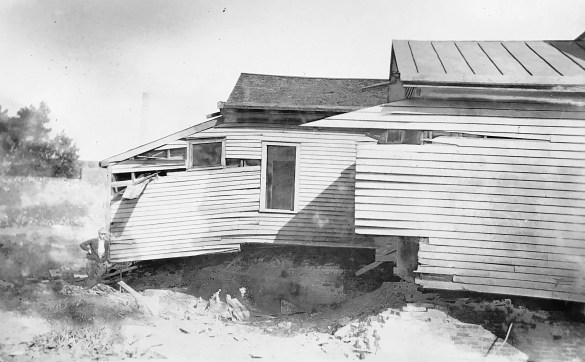
House leaning at a precarious tilt after having apparently been moved from its foundation. Photo by Lewis Reed
The death toll in Gainesville was officially 203, though some accounts place it higher. Property damage was in excess of $13 million dollars, or what would be $1.3 billion in damage by today’s standards. More than 1,600 persons were injured and more than 750 homes were damaged or destroyed. The storm that hit Gainesville on April 6, 1936 remains the fifth deadliest tornado in U.S. history. President Franklin Roosevelt toured the city three days later, and returned in 1938 to rededicate the courthouse and city hall after a massive citywide rebuilding effort.
Sources:
Wikipedia – 1936 Tupelo–Gainesville tornado outbreak
The Digital Library of Georgia
Rockville’s First Manual Training School, 1913
One of my favorite things to do is explore details in old photos and to try and figure out what things are and what the picture is. I was immediately intrigued by this photograph when I saw it in one of my grandfather’s albums. The caption on the photo was, “Manual Training Work at R.H.S. 1913”.
What first struck me about the photo is, it appears to be what used to be the inside of an old school classroom. My eye was first drawn to the chalkboard that runs across the front of the room and down the side. When I looked at the details by enlarging it, the writing on the chalkboard reveals a M-F weekday class schedule. I can just barely make out, Algebra and Latin. The rest of the subjects are illegible.
But I was also intrigued by the caption… what exactly is “manual training” in education, anyway? According to google, the Manual Training movement was the precursor to the vocational training programs in our schools today. First used in the United States in the 1870s in the training of engineers, the movement spread rapidly to general public education. The student would learn to skillfully use tools in drafting, mechanics, wood or metal working, and then would be able to transfer this knowledge to almost any kind of tool or setting.
The Rockville Manual Training School opened on January 21, 1901, with over 50 students admitted.
From “The Montgomery County Story” Vol. 24, No. 2, May 1981 by E. Guy Jewell
At a meeting held on January 8, 1901, the Rockville Manual Training School was established by order of the Board of County School Commissioners. On February 21, 1902, Wilson S. Ward became instructor in Manual Training and remained for several years to develop a course noted as outstanding in the State. In 1908, the School Commissioners opened the Business School in the Rockville High School Building. Prof. Neely Graham, a graduate of the Westchester Normal School and of the Wilmington Business College, was appointed principal of this school. One of the large basement rooms was equipped with business desks and typewriters for the business students.
The classes that were introduced in 1902 eventually grew into the Vocational Course in the High School; the other courses were Academic, General, and Commercial.
Located in Rockville, the school now named Richard Montgomery High School is the oldest public high school in Montgomery County. In 1892, the Board of School Commissioners approved an addition to the existing elementary school in Rockville to create a new “Rockville High School,” serving students from grades one to eleven. The first class of twelve seniors graduated in 1897.
The Montgomery County Sentinel
Snowy Day in 1910 at the Old Montgomery County Fairgrounds
As we’re currently experiencing cold, snowy, icy weather, what better time than now to post these snowy pictures of the old Montgomery County Fair. These snowy images of the Fairgrounds were taken by Lewis Reed in 1910.
From 1846-1932, the Montgomery County Fair took place in Rockville with competitions, entertainment, and food that attracted people from Montgomery County and Washington, DC.
Happy Birthday to Lewis Reed Founder of Reed Brothers Dodge

This ca. 1965 photo of Lewis Reed was taken in the new car showroom at Reed Brothers Dodge original location at the triangle at Veirs Mill Road and Rockville Pike.
Happy 136th birthday Lewis Reed! The founder of Reed Brothers Dodge was born on this day in 1887 in Darnestown, Maryland. In 1915, he founded what would become the oldest Dodge dealership under the same family ownership in the state of Maryland, and one of the oldest in the entire nation.
Lewis Reed was just 27 years old when he started selling cars built by brothers Horace and John Dodge in Detroit. Few people jumped onto the Dodge Brothers bandwagon earlier than Lewis Reed, and not many have lasted longer. Reed Brothers was franchised as a Dodge dealership and service facility less than one year after the first Dodge automobile rolled off the assembly line. Lewis Reed was the first to sell Dodge cars in Montgomery County, Maryland and his company was the first Gulf gas dealer in the Washington, D.C. area. During the early years, Reed Brothers represented several franchise nameplates along with Dodge, including Oldsmobile, Hudson and Essex. The Hudson and Oldsmobile were sold at Reed Brothers from roughly 1917 through 1923.
Lewis Reed was a member of the Gaithersburg Grace Methodist Church where he served as a member and Chairman of the Board of Stewards, a Lay Leader, and President of the Men’s Bible Class. He was one of nine original incorporators of the Gaithersburg-Washington Grove Volunteer Fire Department when it was created by charter in 1928. He was a Charter Member and Past President of the Gaithersburg-Washington Grove Fire Department and a member of the advisory board of the Rockville Branch of the First National Bank of Maryland. He belonged to the Masonic Lodge of Rockville, the Pentalpha Chapter of the Eastern Star and the Rockville Rotary Club. Before opening his Dodge dealership in 1915, Lewis Reed was one of the earliest and most prolific photographers in Montgomery County. Many of his photographs are now part of Montgomery History’s photo archives. Unsurprisingly, his love of both cars and cameras resulted in his taking numerous pictures of car culture all over the State of Maryland as it developed from infancy to supremacy.
Prior to World War I, Lewis Reed’s love of automobiles led him to becoming a chauffeur. Chauffeurs were not only trained to be proficient with their driving skills, but they also had to keep the luxury automobiles in tip top shape which is where his mechanic training would have come into play. He received his training as an automobile mechanic at the Pierce Arrow factory at Buffalo, New York, the Dodge and Hudson factories at Detroit and the Washington Auto College.
Active in the dealership daily until the day of his death, Lewis Reed passed on January 28, 1967 at the age of 79. Shortly after his death, the Senate of Maryland passed Senate Resolution No. 10, expressing “the deepest regret and sympathy of every member of this body,” describing Reed as “a kindly and loyal person completely devoted to his duties” which he carried out “with fairness and human understanding.” The resolution was sponsored by Senator Thomas M. Anderson, Jr. and Senator Louise Gore.
When you look back and consider what has taken place in the world in the past 100 years or so, you gain a perspective of what Lewis Reed faced. He overcame a lot of obstacles throughout his life. He steered his dealership through World War I, The Great Depression and World War II. When Reed Brothers had no new cars to sell for three and a half years and many dealers went bankrupt, he converted his car showroom into a display room and sold GE Washing Machines, Westinghouse Radios, and other large appliances. Reed Brothers Dodge occupied two locations, the original at the Veirs Mill Road and Rockville Pike intersection and the second at 15955 Frederick Road in front of the Shady Grove Metro.
Lewis Reed set an outstanding example through his success, but more importantly through his sacrifices and commitment to the community he served. Today, Bainbridge Shady Grove Metro Apartments pays tribute to the oldest Dodge dealership in Maryland with commemorative art on the former site of the iconic Reed Brothers dealership.

Bainbridge Shady Grove Metro Apartments now stands on the former site of the Reed Brothers Dodge dealership at 15955 Frederick Road. A sculpture now installed on the property pays tribute to the oldest Dodge dealership in Maryland history. More than 20 feet high, and over 6 feet wide, the public art is inspired by 1939 Dodge headlamps, and the fender of a 1957 Dodge pickup truck.





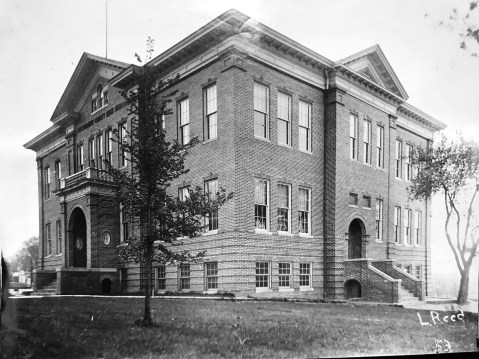

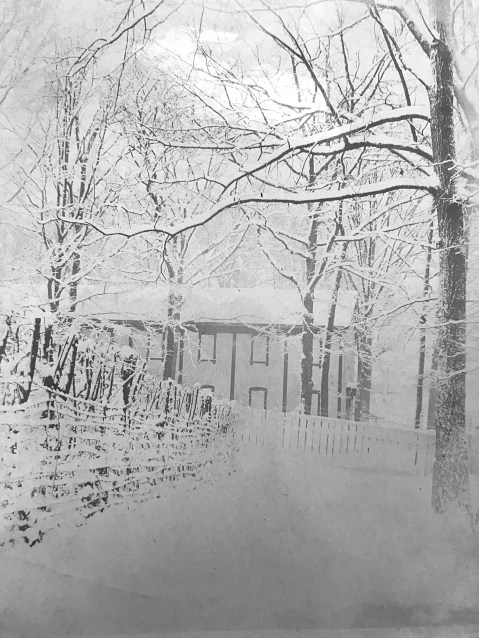









Recent Comments